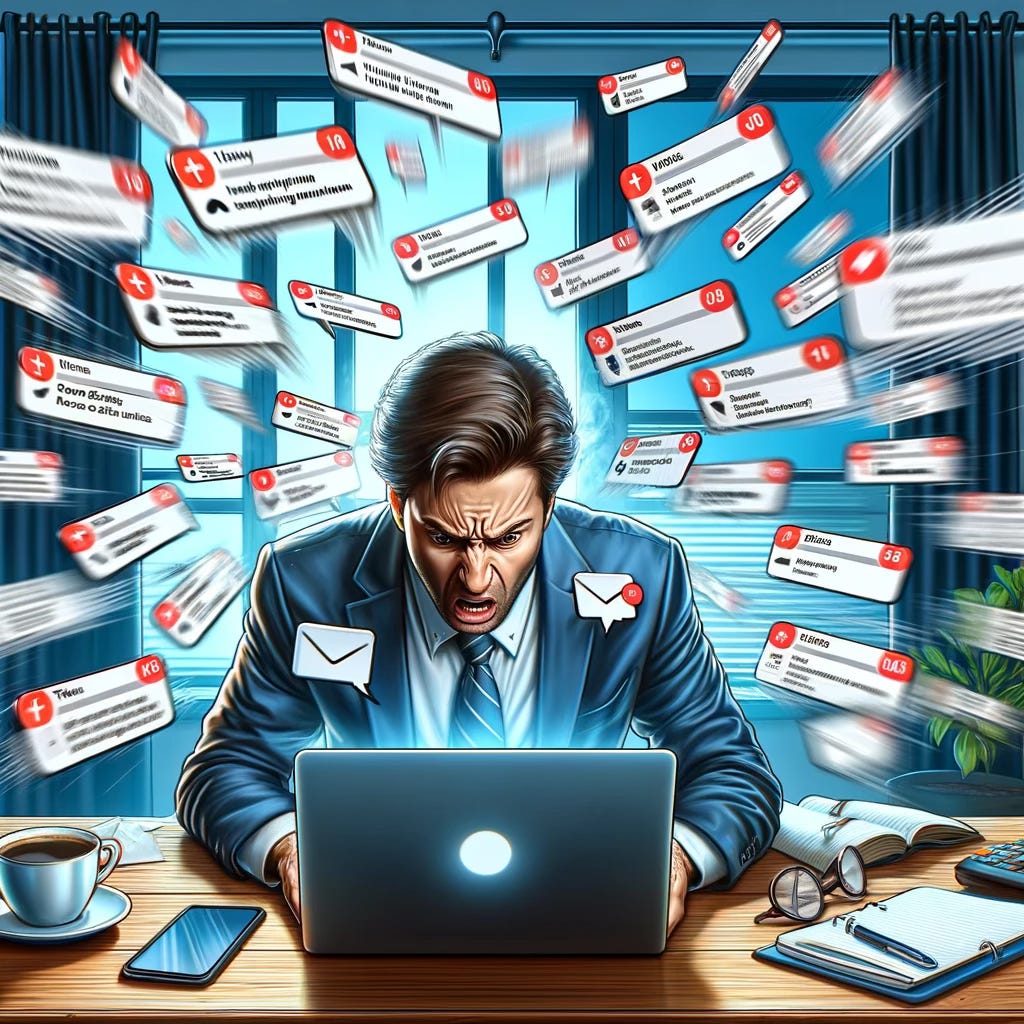Declutter Your Calendar: The Unseen Power of Less for More Effective Leadership
🌟 TL;DR: The Illusion of Productivity in a World of Endless Meetings 🌟
🔍 Ever wake up feeling supercharged to conquer your to-do list, only to find yourself trapped in the endless loop of back-to-back meetings? Let's explore why keeping an open calendar might just be the secret weapon of successful leaders.
The Meeting Trap: A False Sense of Achievement
You've been there: your day starts with a burst of ambition, but then... bam! You're bombarded with emails, instant messages, and unexpected meetings. Suddenly, your whole day is derailed. Sound familiar? ☕📅
A shocking stat: the average person spends 23 hours a week in meetings. With remote and hybrid work on the rise, this number is only growing. But here's the real kicker: a study by Wundamail involving 20,000 remote workers revealed some startling insights:
56% wish they had fewer video calls.
42% often attend meetings where they contribute nothing.
33% struggle to stay focused during these calls.
And guess what? People are 3 times more likely to follow through on written agreements than those made in video calls. Post-meeting, a whopping 42% need written follow-ups to clarify actions, and 30% require even more calls and emails for clarity. 📈
The Illusion of Busy = Productive
73% of those surveyed equate video conferencing with "getting work done." That's over 14,600 people out of 20,000 equating work with meetings. But is squeezing in more meetings truly productive? 🤔
📚🔎Case Study: Facebook and Atlassian's No-Meeting Days Initiative
Background
In an effort to boost productivity and employee satisfaction, tech giants Facebook and Atlassian took a bold step: implementing no-meeting days. This initiative was part of a broader experiment conducted across 76 large companies, spanning over 50 countries, each employing over 1,000 employees.
The Challenge
Before this initiative, like many modern workplaces, both Facebook and Atlassian faced the challenge of meeting overload. This not only hampered employee productivity but also affected their work-life balance and overall well-being.
The Implementation
Facebook and Atlassian introduced at least one no-meeting day per week. This approach was designed to give employees uninterrupted time to focus on deep work, creative thinking, and strategic planning - aspects often sidelined due to constant meetings.
The Impact
The results were significant and positive:
Reduced Stress: The introduction of a single no-meeting day per week led to a 26% reduction in employee stress.
Improved Communication: Despite fewer meetings, communication effectiveness increased by 45%.
Optimal No-Meeting Days: While one day showed notable improvements, the optimal number of no-meeting days was found to be three, striking a balance between necessary collaboration and focused work time. This further reduced stress by 57%.
Increased Productivity: With improved autonomy and engagement, overall productivity saw a marked increase.
Lessons Learned
Balanced Approach: Completely eliminating meetings can lead to a disconnect; hence, a balanced approach is vital.
Employee Autonomy: Giving employees control over their schedules can significantly improve their productivity and satisfaction.
Cultural Shift: This initiative required a shift in the workplace culture, emphasizing output and efficiency over mere presence in meetings.
Conclusion
The case of Facebook and Atlassian demonstrates that reducing meeting frequency can lead to a more engaged, less stressed, and ultimately more productive workforce. This approach challenges traditional work paradigms, encouraging a shift towards valuing quality of work over quantity of meetings.
Reactive vs. Proactive Leadership
Here's the dilemma: back-to-back meetings often push us into a reactive mode, making us feel productive when we're really not. In contrast, proactive leadership – the kind that genuinely moves your business forward – requires space to think, create, and lead. 🚀
The Power of an Empty Calendar
Some of the world's top leaders swear by keeping their calendars open:
Jeff Weiner (ex-CEO of LinkedIn) scheduled up to two hours daily for uninterrupted thinking.
Jeff Bezos (ex-CEO of Amazon) kept two days per week meeting-free for brainstorming and strategic thinking.
Bill Gates (ex-CEO of Microsoft) took biannual week-long retreats just for reading and contemplation.
Richard Branson (ex-CEO of Virgin) advocates for scheduling time to dream and see the bigger picture. 🌐
If you're not adding value to a meeting, leave! - Elon Musk
Five Techniques to Break Free from Meeting Overload
Establish a Proactivity Ratio: Aim for a realistic balance between meetings, proactive work, and emails.
Plan Your Day in Advance: Prioritize tasks and deprioritize less valuable meetings.
Tackle Important Tasks First: Start your day with productivity, not distractions.
Delegate Meeting Attendance: Free up your schedule and empower your team.
Optimize Meeting Lengths: Shorten meetings to focus discussions and save time. ⏱️
Challenge yourself to a 'no-meeting day.' Share your experiences in the comments or on social media using #NoMeetingDay.
💌 Join My Leadership Insights
The Bottom Line: Busyness ≠ Leadership
Blocking out time for strategic thinking is crucial. Remember, a packed calendar isn't a badge of honor; it's a sign that you need to reassess your approach to time management and leadership. 🌟
🚀 Ready to Transform Your Leadership Style?
Embrace the power of an open calendar and make space for what truly matters. Your future self (and your team) will thank you for it. Share your thoughts and experiences in the comments below – let's start a conversation about redefining productivity in leadership!
👉 Don't forget to follow for more insights on leadership and productivity!
This article hopes to offer a fresh perspective on why it's essential to balance meetings with strategic thinking and leadership. Let's start a dialogue on how we can all become better leaders by managing our time more effectively!
🔗 Share the Knowledge
Found this helpful? Share with your network using the easy share button!
📚Additional Reading & Resources
Time Management Books:
"Deep Work: Rules for Focused Success in a Distracted World" by Cal Newport: This book emphasizes the importance of focused work in an increasingly distracted world, aligning well with the concept of minimizing meetings to enhance productivity.
"168 Hours: You Have More Time Than You Think" by Laura Vanderkam: Vanderkam explores the myth of the time crunch and provides strategies for prioritizing important tasks over nonessentials, which complements the idea of prioritizing proactive work over reactive meetings.
"The 80/20 Principle: The Secret to Achieving More with Less" by Richard Koch: This book discusses the idea that 80% of results come from 20% of efforts, advocating for focusing energy on the most essential tasks, much like the concept of strategic, proactive leadership.
"When: The Scientific Secrets of Perfect Timing" by Daniel Pink: Pink's book delves into how timing affects motivation and success, which can be particularly relevant when considering the scheduling of meetings and productive work.
"Essentialism: The Disciplined Pursuit of Less" by Greg McKeown: This book is about focusing on what is essential, paralleling the idea of keeping an open calendar for more strategic thinking and leadership.
"The Productivity Project: Accomplishing More by Managing Your Time, Attention, and Energy" by Chris Bailey: Bailey shares insights on optimizing productivity, which aligns with the theme of effective time management in leadership.
"Organize Tomorrow Today: 8 Ways to Retrain Your Mind to Optimize Performance at Work and in Life" by Jason Selk, Tom Bartow, and Matthew Rudy: This book emphasizes the role of mindset in time management, relevant to the idea of transforming leadership styles.
"Clockwork: Design Your Business to Run Itself" by Mike Michalowicz: Michalowicz offers strategies for business owners to stop micromanaging and gain more free time, echoing the article's focus on reducing meeting overload.
"Four Thousand Weeks: Time Management for Mortals" by Oliver Burkeman: This book takes a philosophical approach to time management, challenging modern productivity norms.
"Make Time: How to Focus on What Matters Every Day" by Jake Knapp and John Zeratsky: This book presents time management as an intentional practice of focusing on meaningful tasks, which resonates with the article's call to prioritize strategically.
Leadership Books:
"Dare to Lead: Brave Work. Tough Conversations. Whole Hearts." by Brené Brown: Brown calls for daring leaders who take responsibility for finding potential in others, relevant to the article's focus on proactive leadership.
"The Four Fixations of a Brilliant Leader" by Alan J. Sears: Sears’s book offers a unique approach to understanding and implementing effective leadership behaviors.
"First, Break All the Rules: What the World's Greatest Managers Do Differently" by Jim Harter: This book is based on Gallup's study of managers and emphasizes the importance of innovative leadership approaches.
"Biased: Uncovering the Hidden Prejudice That Shapes What We See, Think, and Do" by Jennifer L. Eberhardt: Eberhardt's book is crucial for leaders to understand unconscious biases in the workplace.
"The Introverted Leader: Building on Your Quiet Strength" by Jennifer B. Kahnweiler: This book addresses the strengths that introverted individuals can bring to leadership roles.
"The 7 Habits of Highly Effective People" by Stephen R. Covey: Covey’s classic offers timeless insights on proactivity and effective leadership.
"Seeing Around Corners" by Rita McGrath: McGrath teaches leaders how to anticipate and manage change effectively.
"How to Own the Room: Women and the Art of Brilliant Speaking" by Viv Groskop: This book is especially insightful for women in leadership, showcasing how influential women have mastered confidence and communication.
"Thinking, Fast and Slow" by Daniel Kahneman: Kahneman's book explores how our thinking processes can be optimized for better leadership and decision-making.
"Good to Great: Why Some Companies Make the Leap...And Others Don't" by Jim Collins: Collins provides a framework for taking companies from good to great, which can be valuable for leaders aiming to enhance their organizational effectiveness.




